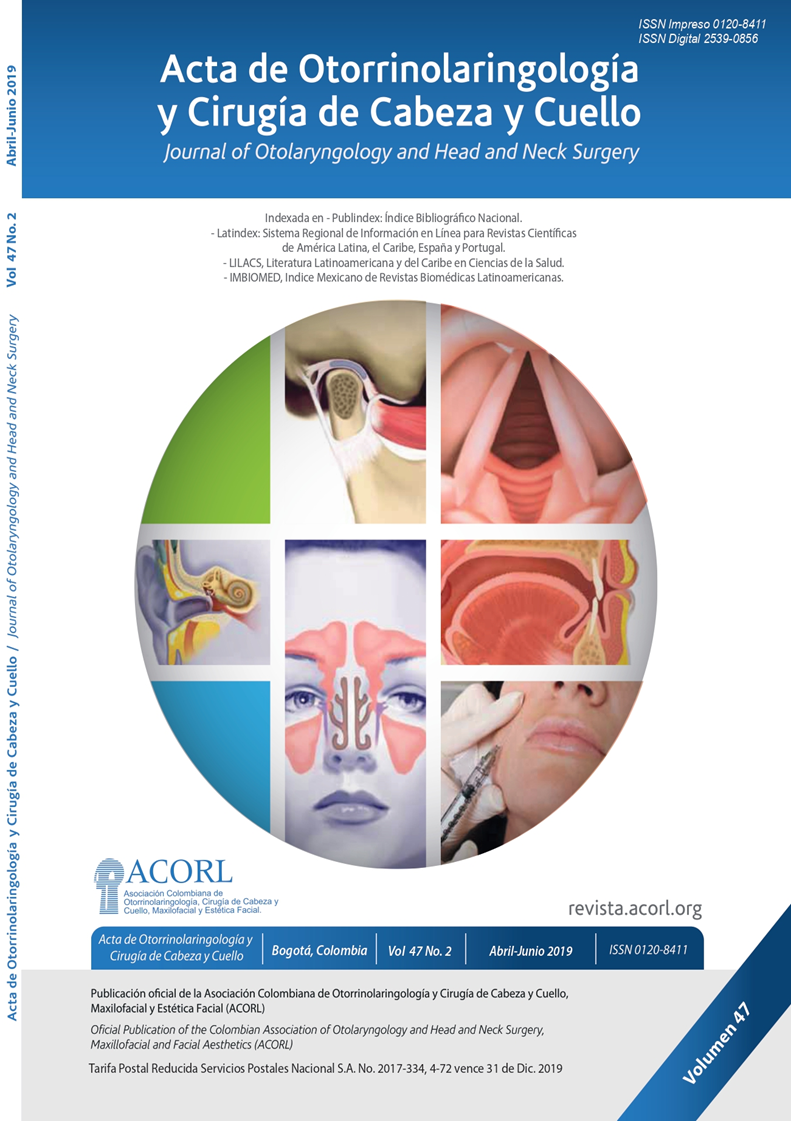Surgical outcome of nasal septal perforation repair with cartilage grafts
Main Article Content
Abstract
Introduction: septal perforations and surgical correction are a challenge for ENT specialists. Several techniques for closing septal perforations are described in the literature; however, its results in terms of effectiveness are variable and with small sample sizes. The technique of closure of septal perforation with cartilage grafts has been performed for 8 years in the ENT department of San Jose? Hospital with a successful clinical response.
Aims: to describe the postoperative results of patients managed with the technique of surgical closure of septal perforation with cartilage grafts, in terms of complications and frequency of residual septal perforation.
Design: descriptive cohort study.
Methods: a cohort of patients managed with the surgical closure technique of septal perforation with grafts of bank cartilage or autologous cartilage are described. Patients were included from January 2014 to June 2018. Demographic, clinical data, complications and presentation of residual septal perforation were extracted from the clinical history
Results: The success rate of septal perforation closure was 78.3%; being the most frequent etiologies antecedent of surgery and idiopathic. The most common complication was epistaxis in 26% of patients, followed by pain in 21.7% in the postoperative period, which improved in subsequent controls.
Conclusion: the results with the technique of closure of septal perforation with bank grafting were satisfactory in this population.
Downloads
Article Details
Este artículo es publicado por la Revista Acta de Otorrinolaringología & Cirugía de Cabeza y Cuello.
Este es un artículo de acceso abierto, distribuido bajo los términos de la LicenciaCreativeCommons Atribución-CompartirIgual 4.0 Internacional.( http://creativecommons.org/licenses/by-sa/4.0/), que permite el uso no comercial, distribución y reproducción en cualquier medio, siempre que la obra original sea debidamente citada.
eISSN: 2539-0856
ISSN: 0120-8411
References
Oberg D, Akerlund A, Johansson L, Bende M. Prevalence of nasal septal perforation: the Skövde population-based study. Rhinology. 2003;41(2):72-5.
Diamantopoulos II, Jones NS. The investigation of nasal septal perforations and ulcers. J Laryngol Otol. 2001;115(7):541-4.
Taylor RJ, Sherris DA. Prosthetics for nasal perforations: a systematic review and meta-analysis. Otolaryngol Head Neck Surg. 2015;152(5):803-10.
Kim SW, Rhee CS. Nasal septal perforation repair: predictive factors and systematic review of the literature. Curr Opin Otolaryngol Head Neck Surg. 2012;20(1):58-65.
Wong S, Raghavan U. Outcome of surgical closure of nasal septal perforation. J Laryngol Otol. 2010;124(8):868-74.
Watson D, Barkdull G. Surgical management of the septal perforation. Otolaryngol Clin North Am. 2009;42(3):483-93.
Bast F, Heimer A, Schrom T. Surgical closure of nasoseptal defects: postoperative patient satisfaction. ORL J Otorhinolaryngol Relat Spec. 2012;74(6):299-303.
Moon IJ, Kim SW, Han DH, Kim ST, Min YG, Lee CH, et al. Predictive factors for the outcome of nasal septal perforation repair. Auris Nasus Larynx. 2011;38(1):52-7.
Kridel RW. Considerations in the etiology, treatment, and repair of septal perforations. Facial Plast Surg Clin North Am. 2004;12(4):435-50, vi.
Schultz-Coulon HJ. Three-layer repair of nasoseptal defects. Otolaryngol Head Neck Surg. 2005;132(2):213-8.
Dosen LK, Haye R. Surgical closure of nasal septal perforation. Early and long term observations. Rhinology. 2011;49(4):486-91.
Romo T, Foster CA, Korovin GS, Sachs ME. Repair of nasal septal perforation utilizing the midface degloving technique. Arch Otolaryngol Head Neck Surg. 1988;114(7):739-42.
Murakami CS, Kriet JD, Ierokomos AP. Nasal reconstruction using the inferior turbinate mucosal flap. Arch Facial Plast Surg. 1999;1(2):97-100.
Bank J, Beederman M, Naclerio RM, Gottlieb LJ. Prelaminated fascia lata free flap for large nasal septal defect reconstruction. J Plast Reconstr Aesthet Surg. 2014;67(10):1440-3.
Pereira C, Santamaría A, Langdon C, López-Chacón M, Hernández-Rodríguez J, Alobid I. Nasoseptal Perforation: from Etiology to Treatment. Curr Allergy Asthma Rep. 2018;18(1):5.
Hong SN, Mutsumay S, Jin HR. Long-term Results of Combined Rhinoplasty and Septal Perforation Repair. JAMA Facial Plast Surg. 2016;18(6):475-80.
Delaney SW, Kridel RWH. Contemporary Trends in the Surgical Management of Nasal Septal Perforations: A Community Survey. Facial Plast Surg. 2019;35(1):78-84.
Newton JR, White PS, Lee MS. Nasal septal perforation repair using open septoplasty and unilateral bipedicled flaps. J Laryngol Otol. 2003;117(1):52-5.
Raol N, Olson K. A novel technique to repair moderate-sized nasoseptal perforations. Arch Otolaryngol Head Neck Surg. 2012;138(8):714-6.
Kaya E, Cingi C, Olgun Y, Soken H, Pinarbasli Ö. Three layer interlocking: a novel technique for repairing a nasal septum perforation. Ann Otol Rhinol Laryngol. 2015;124(3):212-5.
Sapmaz E, Toplu Y, Somuk BT. A new classification for septal perforation and effects of treatment methods on quality of life. Braz J Otorhinolaryngol. 2018.
Kridel RWH, Delaney SW. Discussion: Acellular Human Dermal Allograft as a Graft for Nasal Septal Perforation Reconstruction. Plast Reconstr Surg. 2018;141(6):1525-7.

